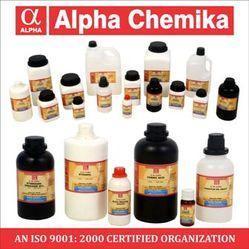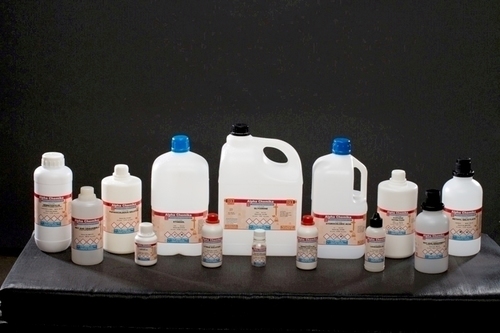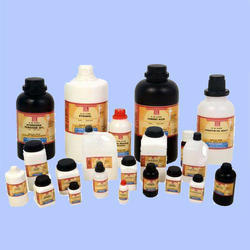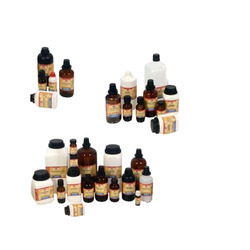Ammoniated Mercury
Price 22255 INR/ Gram
Ammoniated Mercury Specification
- Boiling point
- Not applicable (decomposes)
- Storage Instructions
- Store in tightly closed container, in a cool, dry, well-ventilated place, away from light
- Packaging Type
- Plastic or glass bottles
- Size
- Custom packing sizes available
- Physical State
- Powder
- Shelf Life
- 36 months
- Ph Level
- Neutral to slightly alkaline
- Purity
- 98%
- Density
- 4.09 Gram per cubic centimeter(g/cm3)
- Molecular Weight
- 232.65 g/mol
- Molecular Formula
- Hg(NH2)Cl
- Usage
- Used in chemical analysis, research, and pharmaceutical preparations
- Melting Point
- Decomposes before melting
- CAS No
- 10124-48-8
- Grade
- Laboratory Grade
- Type
- University Lab Chemicals
- Application
- Laboratory, Analytical Reagent, Chemical Synthesis, Ointments (pharmaceutical grade)
- Appearance
- White or yellowish white, odorless, amorphous powder
- Purity(%)
- 98%
Ammoniated Mercury Trade Information
- Minimum Order Quantity
- 500 Grams
- Supply Ability
- 50000 Grams Per Week
- Delivery Time
- 4-5 Days
About Ammoniated Mercury
We are identified as one of the leading organizations, engaged in offering our clients Ammoniated Mercury. This chemical is used as a stabilizing agent for chemicals and analytical samples. At our sound processing unit, we process this chemical using best quality compounds. This chemical is widely used in photography, disinfectants, wood preservatives and fungicides. We pack this Mercuric Ammonium Chloride in moisture free bottles to ensure safe transportation. Also, we offer this chemical at affordable prices.
Specifications :-
- Product Name : Ammoniated Mercury, Mercuric Ammonium Chloride
- Synonyms : Mercuric Amidochloride, Mercuric Ammonium Chloride, Infusible White Percipitate, Mercury(II) Amide Chloride.
- CAS NO : 10124-48-8
- Appearance : Fine white powder
- Odor : Odorless
- Residue on ignition : 0.2% max
- Moisture Content : 1.0% max
- Mercurous Compounds : 0.2% max
- Assay : 98% min
Application :-
- This compound is used as an antiseptic skin & opthalmic ointment.
- Also used to treat impetigo, minor skin infections, psoriasis.
Precutions :-
Excessive use may irritate the skin and may cause dermatitis, so consult your pharmacist.
Features :-
- Slightly soluble in water
- Accurate composition
- Longer shelf life
Key Applications of Ammoniated Mercury
Ammoniated Mercury is widely utilized in chemical analysis, laboratory research, and the synthesis of various compounds. Its use in ointments illustrates its pharmaceutical importance, provided the grade is suitable. Analysts favor it as an accurate reagent due to its stable composition and high purity, vital for reproducible results in complex experimental protocols.
Safety and Handling Protocols
Handling Ammoniated Mercury mandates rigorous safety measures due to its toxicity and potential environmental hazard. Users should employ protective equipment and work within ventilated areas. Contact with skin and eyes must be strictly avoided, and all operations should comply with hazardous materials regulations. Proper storagetightly sealed containers, away from lightis essential to maintain its stability and shelf life.
Custom Packaging and Storage Options
Suppliers offer custom packing sizes to meet laboratory and research needs. The product is packaged in durable plastic or glass bottles to safeguard its integrity and support safe transportation. Storing Ammoniated Mercury correctly extends its shelf life up to thirty-six months, ensuring efficacy over time.
FAQs of Ammoniated Mercury:
Q: How should Ammoniated Mercury be handled to ensure safety in the laboratory?
A: Ammoniated Mercury must be handled with protective equipment, such as gloves and goggles, and in areas with adequate ventilation. It is crucial to avoid direct contact with skin and eyes and to follow all regulatory guidelines for hazardous materials to minimize health risks.Q: What is the recommended storage process for Ammoniated Mercury?
A: Store Ammoniated Mercury in tightly closed containers made of plastic or glass, in a cool, dry, and well-ventilated location, away from direct light. These precautions help maintain its stability and preserve the products shelf life.Q: Where is Ammoniated Mercury typically used, and what are its main applications?
A: This compound is primarily utilized in laboratory research, chemical analysis, and chemical synthesis. Its high purity makes it suitable as an analytical reagent and for certain pharmaceutical preparations such as ointments, provided proper grade is selected.Q: What are the benefits of using Ammoniated Mercury in analytical and research processes?
A: Ammoniated Mercurys stable composition and 98% purity offer highly reliable results in laboratory analyses. Its solubility in ammonia allows versatility in chemical synthesis, supporting precise research and development activities.Q: Why is adequate ventilation necessary when working with Ammoniated Mercury?
A: Adequate ventilation is essential because decomposition of Ammoniated Mercury can emit toxic fumes, including mercury vapors and nitrogen oxides. Proper airflow reduces the risk of inhalation exposure and ensures a safer working environment.Q: How is Ammoniated Mercury transported and what precautions are required?
A: As a toxic and environmentally hazardous substance (UN 2025), Ammoniated Mercury must be transported according to regulatory standards, using approved packaging and labeling to ensure safe handling and minimize risk during transit.

Price:
- 50
- 100
- 200
- 250
- 500
- 1000+
More Products in Mercury Salts Category
Mercurous Chloride
Price 100-500 INR / Kilograms
Minimum Order Quantity : 25GM Kilograms
Purity(%) : 99%
Type : Other
Grade : Laboratory Grade
CAS No : 10112911
MERCURIC NITRATE AR (monohydrate)
Price 32504 INR / Gram
Minimum Order Quantity : 500 Grams
Purity(%) : 99.02%
Type : Other, Analytical Reagent (AR) Monohydrate
Grade : LABORATORY Grade
CAS No : 7783348
Mercuric Oxide
Price 32080 INR / Gram
Minimum Order Quantity : 500 Grams, ,
Purity(%) : 99%
Type : University Lab Chemicals
Grade : Laboratory Grade
CAS No : 21908532
Mercurous Sulphate
Price 2905 INR / Gram
Minimum Order Quantity : 25 Grams
Purity(%) : 96%
Type : University Lab Chemicals
Grade : Laboratory Grade
CAS No : 7783360
"Only deals in retail accepting orders upto 500ml only".
 |
ALPHA CHEMIKA
All Rights Reserved.(Terms of Use) Developed and Managed by Infocom Network Private Limited. |
 English
English Spanish
Spanish French
French German
German Italian
Italian Chinese (Simplified)
Chinese (Simplified) Japanese
Japanese Korean
Korean Arabic
Arabic Portuguese
Portuguese


 Send Inquiry
Send Inquiry






